Are you craving the authentic flavors of Mexico? Look no further! How To Cook Authentic Mexican Tacos is easy with gaymexico.net. We’ll explore the art of making delicious, traditional tacos that will transport you straight to the streets of Mexico. Discover the secrets to perfect taco fillings, tortillas, and salsas, and bring the vibrant taste of Mexico to your home. From classic carne asada to flavorful al pastor, we’ve got you covered. Join us on this culinary journey and become a taco master. Learn more about Mexican culinary traditions, LGBTQ+ friendly destinations, and vibrant cultural experiences at gaymexico.net. Embrace the zest of Mexican gastronomy with exciting recipes and the best cooking practices for unforgettable dishes.
1. What Makes Tacos “Authentic” Mexican?
Authentic Mexican tacos prioritize simplicity, quality ingredients, and traditional cooking methods. These tacos emphasize fresh, local ingredients and time-honored recipes passed down through generations.
Here’s a breakdown:
- Simple Ingredients: Authentic tacos typically feature a few key ingredients, allowing the flavors of each component to shine. This often includes high-quality meat, fresh vegetables, and homemade salsas.
- Traditional Cooking Methods: Many authentic taco recipes involve slow-cooking meats, using techniques like braising or grilling over open flames. This helps develop deep, rich flavors.
- Fresh Tortillas: Authentic Mexican tacos use corn tortillas that are often homemade or sourced from local tortillerias. The tortillas are usually smaller and thicker than those found in many American supermarkets.
- Minimal Toppings: While toppings are important, authentic tacos tend to focus on enhancing the existing flavors rather than masking them. Common toppings include chopped onion, cilantro, and a squeeze of lime.
- Regional Variations: Authentic Mexican tacos vary widely depending on the region. From the seafood tacos of Baja California to the cochinita pibil of the Yucatan Peninsula, each region has its own unique style and flavors.
- Cultural Significance: Tacos are deeply rooted in Mexican culture and history, often reflecting the culinary traditions and agricultural practices of a particular area.
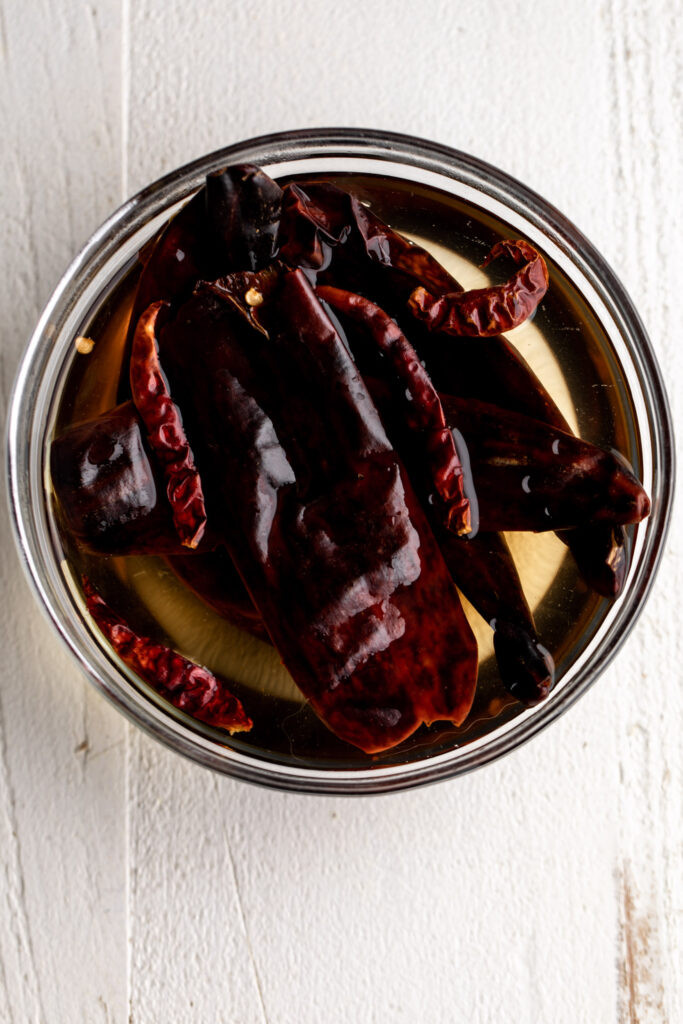 Close-up of authentic Mexican tacos with various toppings
Close-up of authentic Mexican tacos with various toppings
2. What Are The Key Ingredients for Authentic Mexican Tacos?
The key ingredients for authentic Mexican tacos include high-quality protein, corn tortillas, and fresh toppings. The specifics vary by taco type, but these elements are fundamental.
Let’s explore the essentials:
- Protein: This is often the star of the taco. Popular options include:
- Carne Asada: Grilled steak, typically marinated for flavor.
- Al Pastor: Marinated pork, cooked on a vertical spit and shaved thinly.
- Carnitas: Slow-cooked, shredded pork.
- Barbacoa: Slow-cooked meat (traditionally sheep or goat, but often beef in the US).
- Chicken: Grilled or shredded chicken, often marinated.
- Seafood: Fish or shrimp, grilled, fried, or sautéed.
- Corn Tortillas: These are a must for authentic tacos. Look for high-quality tortillas that are soft and pliable. Warming them on a comal or skillet before serving is essential.
- Toppings: Simple, fresh toppings are key:
- Onion: Finely chopped white onion is a common topping.
- Cilantro: Freshly chopped cilantro adds a bright, herbaceous flavor.
- Lime: Lime wedges are essential for squeezing over the tacos, adding acidity and brightness.
- Salsa: A good salsa can make or break a taco. Options include:
- Salsa Verde: Made with tomatillos, chili peppers, onion, cilantro, and lime.
- Salsa Roja: Made with tomatoes, chili peppers, onion, garlic, and spices.
- Pico de Gallo: A fresh salsa made with tomatoes, onion, cilantro, jalapeño, and lime.
- Optional Ingredients:
- Cheese: Queso fresco or Oaxaca cheese are common choices.
- Radishes: Thinly sliced radishes add a peppery crunch.
- Avocado/Guacamole: Adds creaminess and richness.
3. How Do You Prepare Authentic Mexican Taco Fillings?
Preparing authentic Mexican taco fillings involves marinating, slow-cooking, and grilling techniques to develop rich, complex flavors. Each filling has its unique preparation method.
Here’s a guide to preparing some popular taco fillings:
- Carne Asada:
- Marinate: Marinate thin-cut steak (like skirt or flank steak) in a mixture of lime juice, garlic, cilantro, soy sauce, and spices (such as cumin and chili powder) for at least 30 minutes, or up to several hours.
- Grill: Grill the steak over high heat to your desired doneness.
- Chop: Chop the steak into small pieces.
- Al Pastor:
- Marinate: Marinate thin slices of pork in a blend of chili peppers, pineapple juice, vinegar, and spices (such as achiote, cumin, and oregano) for at least several hours, or overnight.
- Cook: Traditionally cooked on a vertical spit, but can also be pan-fried or baked.
- Shave: Shave the pork thinly.
- Carnitas:
- Slow-Cook: Slow-cook pork shoulder (butt) in lard (or oil) with orange, garlic, and spices (such as bay leaves, cumin, and oregano) until the meat is tender and easily shreds.
- Shred: Shred the pork.
- Crisp: Crisp the shredded pork in a skillet or under the broiler for added texture.
- Barbacoa:
- Slow-Cook: Traditionally, barbacoa involves slow-cooking meat (such as beef cheeks or lamb) in an underground pit. However, you can achieve similar results by slow-cooking the meat in a covered pot or slow cooker with chili peppers, spices, and broth.
- Shred: Shred the meat.
- Chicken:
- Marinate: Marinate chicken thighs or breasts in a mixture of lime juice, garlic, chili powder, cumin, and other spices.
- Grill or Bake: Grill or bake the chicken until cooked through.
- Shred: Shred the chicken.
- Seafood:
- Marinate (optional): Marinate fish or shrimp in lime juice, garlic, and spices.
- Grill, Fry, or Sauté: Grill, fry, or sauté the seafood until cooked through.
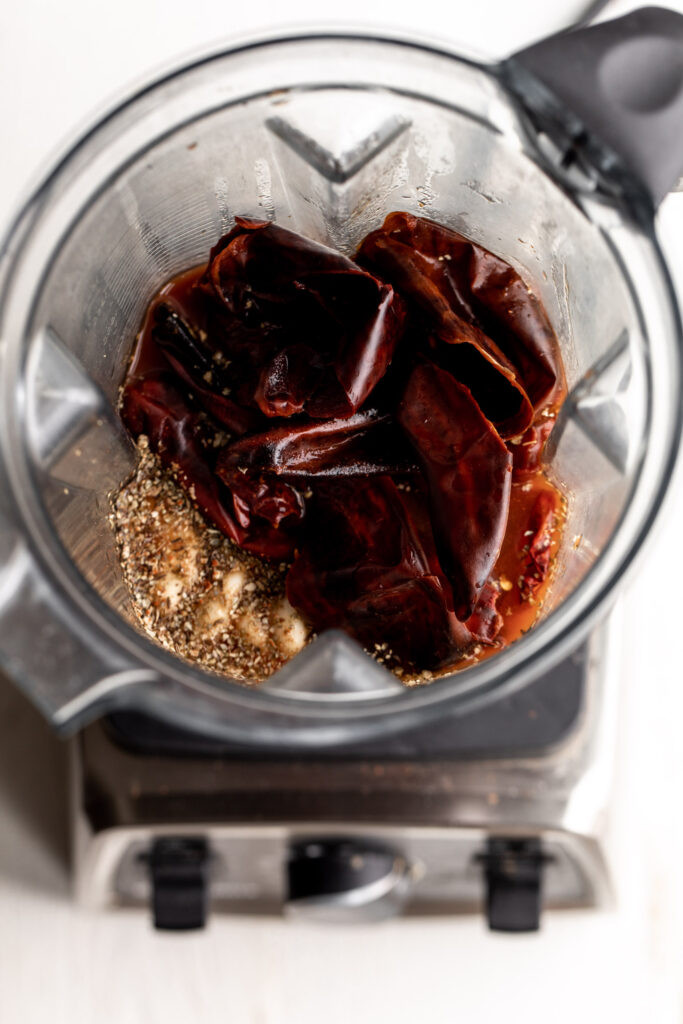 Preparing authentic Mexican taco fillings
Preparing authentic Mexican taco fillings
4. How Do You Make Authentic Corn Tortillas?
Making authentic corn tortillas involves a few simple ingredients and a bit of practice. The key is to use masa harina and a tortilla press for the best results.
Here’s a step-by-step guide:
- Ingredients:
- 2 cups masa harina (corn flour specifically for tortillas)
- 1 1/2 cups warm water (approximately)
- Instructions:
- Mix the Dough: In a large bowl, combine the masa harina and warm water. Mix with your hands until a soft, pliable dough forms. The dough should not be too sticky or too dry. Add more water or masa harina as needed to achieve the right consistency.
- Let the Dough Rest: Cover the dough with a damp cloth and let it rest for about 15-20 minutes. This allows the masa harina to fully hydrate.
- Divide the Dough: Divide the dough into small balls, about 1-1.5 inches in diameter. This should make about 16-20 tortillas.
- Prepare the Tortilla Press: Line the plates of a tortilla press with plastic wrap or pieces of a plastic bag.
- Press the Tortillas: Place one ball of dough between the plastic-lined plates of the tortilla press. Close the press and press down firmly to flatten the dough into a thin, round tortilla.
- Cook the Tortillas: Heat a comal or griddle over medium-high heat. Carefully peel the tortilla from the plastic and place it on the hot surface.
- Cook Each Side: Cook the tortilla for about 30 seconds on the first side, until it starts to lightly brown. Flip and cook for about 1 minute on the second side. Flip again and cook for another 30 seconds to puff it up slightly.
- Keep Warm: As the tortillas are cooked, stack them in a tortilla warmer or wrap them in a clean kitchen towel to keep them warm and soft.
- Tips:
- Consistency is Key: The dough should be soft and pliable, but not sticky. If it’s too sticky, add a bit more masa harina. If it’s too dry, add a bit more water.
- Warm Water: Using warm water helps the masa harina hydrate properly.
- Hot Surface: Make sure the comal or griddle is hot before cooking the tortillas. This will help them cook quickly and evenly.
- Don’t Overcook: Overcooked tortillas will be dry and brittle. They should be soft and pliable.
- Practice Makes Perfect: It may take a few tries to get the hang of pressing and cooking tortillas, so don’t get discouraged if your first few aren’t perfect.
5. What Are Some Popular Authentic Mexican Taco Recipes?
Some popular authentic Mexican taco recipes include carne asada, al pastor, carnitas, and barbacoa. Each offers a unique flavor profile and regional variation.
Here’s a closer look at each:
- Carne Asada Tacos:
- Description: Grilled steak tacos, typically made with marinated skirt or flank steak.
- Key Ingredients: Thin-cut steak, lime juice, garlic, cilantro, cumin, chili powder.
- Toppings: Chopped onion, cilantro, lime wedges, salsa.
- Al Pastor Tacos:
- Description: Marinated pork tacos, cooked on a vertical spit and shaved thinly.
- Key Ingredients: Thin slices of pork, chili peppers, pineapple juice, vinegar, achiote, cumin, oregano.
- Toppings: Chopped onion, cilantro, pineapple chunks, salsa.
- Carnitas Tacos:
- Description: Slow-cooked, shredded pork tacos.
- Key Ingredients: Pork shoulder (butt), lard (or oil), orange, garlic, bay leaves, cumin, oregano.
- Toppings: Chopped onion, cilantro, lime wedges, salsa.
- Barbacoa Tacos:
- Description: Slow-cooked meat tacos (traditionally sheep or goat, but often beef in the US).
- Key Ingredients: Beef cheeks or lamb, chili peppers, spices, broth.
- Toppings: Chopped onion, cilantro, lime wedges, salsa.
- Tacos de Birria:
- Description: A flavorful meat stew served in tacos with consommé for dipping.
- Key Ingredients: Beef chuck roast, guajillo chilies, ancho chilies, chiles de arbol, Mexican oregano, cumin.
- Toppings: Chopped onion, cilantro, lime wedges, Oaxaca cheese (optional).
- Fish Tacos (Tacos de Pescado):
- Description: Fried or grilled fish tacos, popular in Baja California.
- Key Ingredients: White fish (such as cod or mahi-mahi), beer batter (for fried), cabbage slaw, lime crema.
- Toppings: Cabbage slaw, lime crema, pico de gallo, avocado.
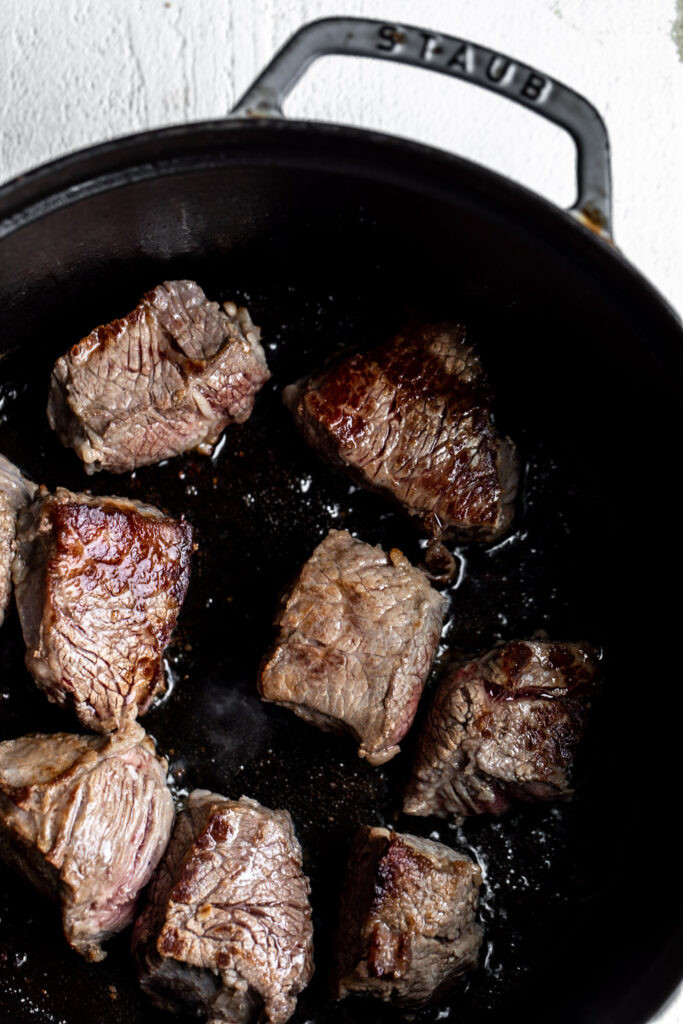 Selection of popular authentic Mexican taco recipes
Selection of popular authentic Mexican taco recipes
6. How Can LGBTQ+ Travelers Experience Authentic Mexican Tacos in Mexico?
LGBTQ+ travelers can experience authentic Mexican tacos in Mexico by exploring diverse culinary scenes in welcoming cities. Focus on inclusive establishments and local markets.
Here’s how to make the most of your culinary adventure:
- Visit LGBTQ+-Friendly Destinations: Cities like Puerto Vallarta, Mexico City, and Guadalajara are known for their vibrant LGBTQ+ communities and welcoming atmospheres. These cities offer a wide range of dining options, from traditional taco stands to upscale restaurants.
- Explore Local Markets: Visit local markets (mercados) to sample a variety of authentic tacos and other Mexican dishes. Markets are great places to find regional specialties and interact with local vendors.
- Seek Out Inclusive Establishments: Look for restaurants and taco stands that are known for being LGBTQ+-friendly. Online reviews and recommendations from local LGBTQ+ organizations can be helpful in finding these places.
- Take a Food Tour: Consider joining a food tour that focuses on authentic Mexican cuisine. Many tours are available in LGBTQ+-friendly cities and can provide a guided experience of the local culinary scene.
- Learn Some Spanish: Knowing a few basic Spanish phrases can enhance your experience and make it easier to communicate with vendors and restaurant staff.
- Respect Local Culture: While many areas in Mexico are welcoming to LGBTQ+ travelers, it’s important to be respectful of local customs and traditions.
- Connect with Local LGBTQ+ Community: Reach out to local LGBTQ+ organizations or community centers for recommendations and insights on the best places to eat and experience authentic Mexican culture.
- Try Regional Specialties: Be sure to try regional taco specialties, such as cochinita pibil in the Yucatan Peninsula or fish tacos in Baja California.
Gaymexico.net offers valuable resources for LGBTQ+ travelers, including recommendations for LGBTQ+-friendly destinations, events, and businesses. This can help you plan a trip that is both safe and enjoyable.
7. What Are Some Tips for Making the Best Authentic Mexican Tacos at Home?
To make the best authentic Mexican tacos at home, focus on high-quality ingredients, proper cooking techniques, and attention to detail. These tips will elevate your taco game.
Here are some essential tips:
- Use High-Quality Ingredients:
- Fresh Tortillas: Use fresh, high-quality corn tortillas. If possible, make your own or buy them from a local tortilleria.
- Good Quality Meat: Choose good quality cuts of meat for your fillings. Marinate them properly to enhance flavor and tenderness.
- Fresh Produce: Use fresh, ripe produce for your toppings and salsas.
- Master the Cooking Techniques:
- Proper Searing: Sear the meat properly to develop a flavorful crust.
- Slow-Cooking: Slow-cook meats like carnitas and barbacoa to achieve maximum tenderness and flavor.
- Grilling: Grill meats like carne asada and chicken to perfection.
- Make Your Own Salsas:
- Fresh Ingredients: Use fresh ingredients to make your own salsas. This will give you more control over the flavor and heat level.
- Roasting: Roasting the vegetables (such as tomatoes, tomatillos, and chili peppers) before blending can add depth of flavor to your salsas.
- Warm the Tortillas:
- Comal or Skillet: Warm the tortillas on a comal or skillet before serving. This will make them more pliable and flavorful.
- Avoid Microwaving: Microwaving can make the tortillas tough and rubbery.
- Don’t Overload the Tacos:
- Balance: Don’t overload the tacos with too many fillings and toppings. The goal is to create a balance of flavors and textures.
- Simplicity: Sometimes, less is more. Simple tacos with just a few high-quality ingredients can be incredibly delicious.
- Garnish with Fresh Herbs:
- Cilantro: Garnish your tacos with fresh cilantro for a burst of flavor.
- Other Herbs: Consider using other herbs like Mexican oregano or epazote for added complexity.
- Serve with Lime Wedges:
- Acidity: Serve your tacos with lime wedges. A squeeze of lime adds acidity and brightness to the flavors.
- Experiment with Flavors:
- Regional Variations: Don’t be afraid to experiment with different regional variations of tacos.
- Personal Touches: Add your own personal touches to your taco recipes.
- Practice Makes Perfect:
- Refine Your Skills: Making authentic Mexican tacos takes practice. Don’t be discouraged if your first few attempts aren’t perfect.
- Keep Trying: Keep experimenting and refining your skills until you achieve the desired results.
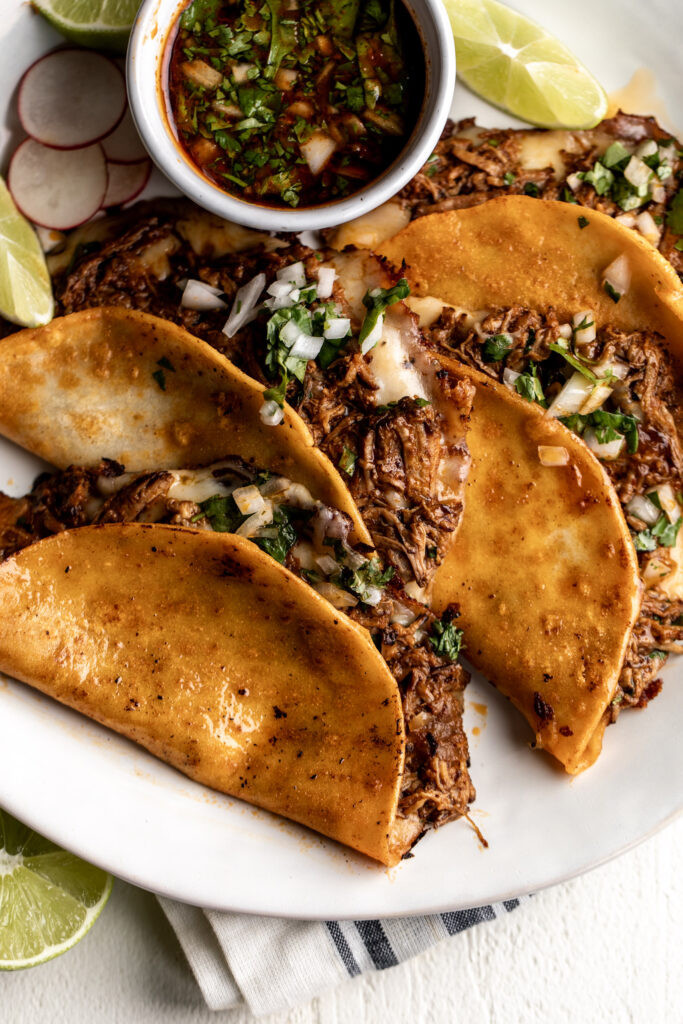 Tips for making the best authentic Mexican tacos at home
Tips for making the best authentic Mexican tacos at home
8. Where Can You Find Authentic Mexican Taco Recipes?
You can find authentic Mexican taco recipes in cookbooks, cooking websites, and from Mexican chefs and home cooks. Online resources offer diverse recipes and tips.
Here are some great places to look:
- Cookbooks:
- Diana Kennedy: Diana Kennedy is a renowned expert on Mexican cuisine. Her cookbooks, such as “The Art of Mexican Cooking” and “From My Mexican Kitchen,” offer a wealth of authentic taco recipes and techniques.
- Rick Bayless: Rick Bayless is another well-known chef and author who specializes in Mexican cuisine. His cookbooks, such as “Mexican Everyday” and “Authentic Mexican,” feature a variety of taco recipes.
- Cooking Websites and Blogs:
- Mexico in My Kitchen: This website, run by Mexican home cook Mely Martínez, offers a wide range of authentic Mexican recipes, including many different types of tacos.
- Pati’s Mexican Table: Pati Jinich is a Mexican chef and cookbook author who shares her favorite recipes on her website and TV show.
- TheSpruce Eats: This website has a comprehensive collection of Mexican recipes, including many different taco variations.
- Allrecipes: This website has a large community of home cooks who share their favorite recipes. You can find many different taco recipes here, with reviews and ratings from other cooks.
- YouTube Channels:
- Mexican Food Memories: This YouTube channel features videos of Mexican home cooks sharing their favorite recipes and cooking techniques.
- De mi Rancho a Tu Cocina: This YouTube channel, hosted by a Mexican grandmother, offers a glimpse into traditional Mexican cooking.
- Mexican Chefs and Home Cooks:
- Local Restaurants: Visit local Mexican restaurants and ask the chefs for their recommendations and recipes.
- Community Events: Attend community events and festivals where Mexican food is served. This is a great way to sample different types of tacos and learn about authentic Mexican cuisine.
- Gaymexico.net:
- Cultural Insights: Explore the cultural insights and local recommendations on gaymexico.net for an immersive experience.
9. How Do You Customize Authentic Mexican Tacos to Dietary Needs?
Customizing authentic Mexican tacos to dietary needs involves making substitutions and adjustments to accommodate vegetarian, vegan, gluten-free, and other requirements.
Here’s how to adapt taco recipes for different diets:
- Vegetarian Tacos:
- Protein Alternatives: Substitute meat with vegetarian protein sources such as:
- Beans: Black beans, pinto beans, or refried beans.
- Mushrooms: Sautéed mushrooms, such as cremini or portobello.
- Sweet Potatoes: Roasted sweet potatoes.
- Quinoa: Seasoned quinoa.
- Soy Products: Tofu or tempeh, seasoned with Mexican spices.
- Toppings: Use vegetarian-friendly toppings such as:
- Salsa: Salsa verde, salsa roja, pico de gallo.
- Vegetables: Grilled corn, bell peppers, onions.
- Dairy: Cheese (if not vegan), sour cream.
- Avocado/Guacamole: Adds creaminess and richness.
- Protein Alternatives: Substitute meat with vegetarian protein sources such as:
- Vegan Tacos:
- Protein Alternatives: Use the same vegetarian protein sources as above, ensuring they are prepared without any animal products.
- Vegan Cheese: Use vegan cheese alternatives, such as shredded cashew cheese or nutritional yeast.
- Toppings: Omit dairy toppings and use vegan-friendly options such as:
- Vegan Sour Cream: Made from cashews or tofu.
- Avocado/Guacamole: Adds creaminess and richness.
- Salsa: Salsa verde, salsa roja, pico de gallo.
- Vegetables: Grilled corn, bell peppers, onions.
- Gluten-Free Tacos:
- Corn Tortillas: Use corn tortillas, as they are naturally gluten-free.
- Check Ingredients: Be sure to check the labels of all ingredients to ensure they are gluten-free, including spices and marinades.
- Avoid Flour Tortillas: Do not use flour tortillas, as they contain gluten.
- Low-Carb Tacos:
- Lettuce Wraps: Use lettuce wraps instead of tortillas.
- Cauliflower Tortillas: Use cauliflower tortillas.
- Fillings: Focus on low-carb fillings such as:
- Grilled Chicken or Fish: Seasoned with Mexican spices.
- Avocado/Guacamole: Adds healthy fats and flavor.
- Salsa: Salsa verde, salsa roja, pico de gallo.
- Cheese: Use small amounts of cheese (if not dairy-free).
- Dairy-Free Tacos:
- Omit Dairy: Omit cheese, sour cream, and other dairy toppings.
- Dairy-Free Alternatives: Use dairy-free alternatives such as:
- Vegan Sour Cream: Made from cashews or tofu.
- Avocado/Guacamole: Adds creaminess and richness.
- Salsas: Use salsas that do not contain dairy, such as salsa verde, salsa roja, or pico de gallo.
- Allergy Considerations:
- Careful Ingredient Selection: Always carefully select ingredients to avoid common allergens such as nuts, soy, and shellfish.
- Cross-Contamination: Be mindful of cross-contamination when preparing tacos for people with allergies. Use separate cutting boards and utensils, and clean surfaces thoroughly.
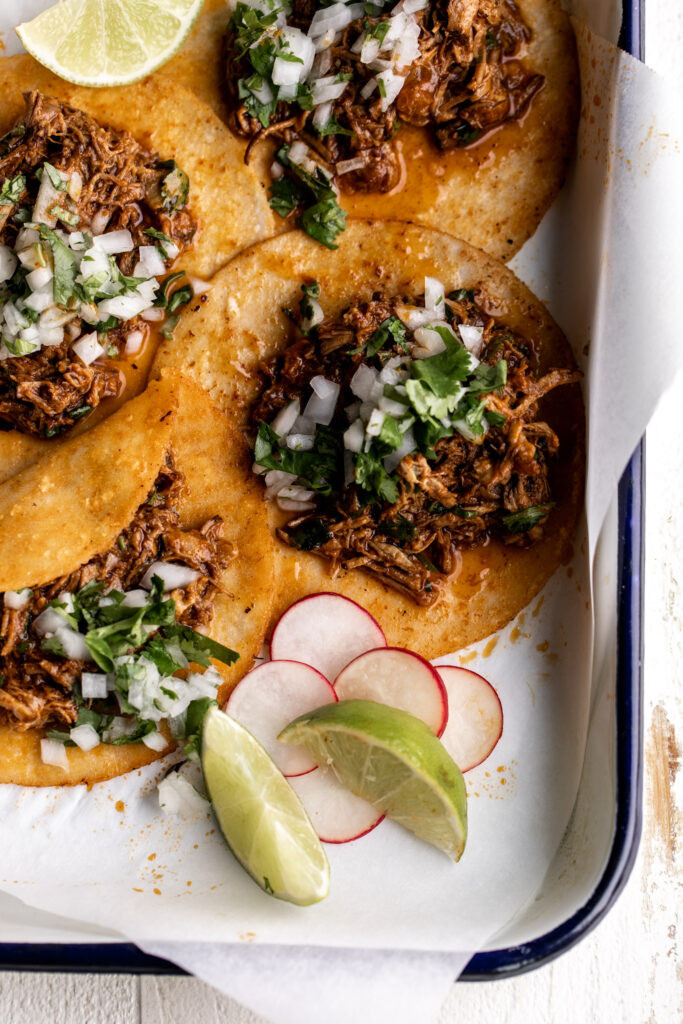 Customizing authentic Mexican tacos to dietary needs
Customizing authentic Mexican tacos to dietary needs
10. How Can You Elevate Your Authentic Mexican Taco Presentation?
Elevating your authentic Mexican taco presentation involves thoughtful plating, vibrant garnishes, and creative serving methods. These details enhance the dining experience.
Here are some tips to make your tacos visually appealing:
- Choose the Right Plates:
- Colorful Plates: Use colorful plates that complement the colors of the tacos.
- Rustic Plates: Use rustic, earthenware plates for a more authentic look.
- Wooden Boards: Serve tacos on wooden boards for a casual, rustic presentation.
- Arrange the Tacos Artistically:
- Stacking: Stack the tacos neatly on the plate, slightly overlapping each other.
- Spacing: Space the tacos evenly on the plate, allowing each taco to be seen.
- Garnish with Fresh Herbs:
- Cilantro Sprigs: Garnish the tacos with fresh cilantro sprigs.
- Other Herbs: Use other herbs like Mexican oregano or epazote for added visual appeal.
- Add Vibrant Toppings:
- Colorful Salsas: Use colorful salsas such as salsa verde, salsa roja, and pico de gallo.
- Sliced Radishes: Add thinly sliced radishes for a pop of color and crunch.
- Pickled Onions: Add pickled onions for a tangy and colorful garnish.
- Serve with Lime Wedges:
- Presentation: Arrange lime wedges neatly on the plate.
- Garnish: Use lime wedges as a garnish, placing them strategically on the plate.
- Use Creative Serving Methods:
- Taco Stands: Use taco stands to hold the tacos upright, making them easier to eat and visually appealing.
- Mini Taco Bar: Create a mini taco bar with all the fillings and toppings arranged in separate bowls.
- Add a Side of Consommé:
- Dipping: Serve the tacos with a side of consommé for dipping (especially for birria tacos).
- Presentation: Ladle the consommé into small bowls or cups for dipping.
- Use Garnishes to Tell a Story:
- Regional Garnishes: Use garnishes that are specific to the region where the tacos originated.
- Authentic Touches: Add authentic touches that reflect the culture and history of Mexican cuisine.
- Keep it Clean and Simple:
- Avoid Clutter: Avoid cluttering the plate with too many garnishes and toppings.
- Focus: Focus on creating a clean, simple presentation that highlights the flavors and textures of the tacos.
- Lighting:
- Natural Light: If possible, photograph your tacos in natural light.
- Artificial Light: If using artificial light, make sure it is soft and diffused.
Want to dive deeper into the vibrant culture of Mexico and connect with the LGBTQ+ community? Visit gaymexico.net for the best travel tips, cultural insights, and community connections! Discover the heart of Mexico, one taco at a time.
FAQ: How to Cook Authentic Mexican Tacos
- What is the key to authentic Mexican taco flavor? The key is using high-quality, fresh ingredients and traditional cooking methods.
- Can I use flour tortillas instead of corn? For authentic tacos, corn tortillas are preferred, but flour tortillas can be used for a Tex-Mex variation.
- What are the best cuts of meat for carne asada? Skirt steak or flank steak are excellent choices for carne asada due to their flavor and ability to marinate well.
- How do I make sure my tortillas don’t break? Warm your tortillas on a comal or skillet before filling them to make them more pliable and prevent them from breaking.
- What is the difference between salsa verde and salsa roja? Salsa verde is made with tomatillos, while salsa roja is made with tomatoes, giving them distinct flavors and colors.
- How do I make vegan Mexican tacos? Substitute meat with plant-based options like beans, mushrooms, or tofu, and use vegan cheese and sour cream alternatives.
- What are some popular taco toppings in Mexico? Common toppings include chopped onion, cilantro, lime wedges, and various salsas like pico de gallo.
- How can I add more heat to my tacos? Use hotter chili peppers in your salsa or add a dash of hot sauce to your tacos for an extra kick.
- What is the best way to store leftover taco fillings? Store leftover fillings in an airtight container in the refrigerator for up to 3-4 days.
- Can I make tacos ahead of time for a party? Prepare the fillings and toppings in advance, but assemble the tacos just before serving to prevent the tortillas from getting soggy.
For more insights, travel guides, and LGBTQ+ friendly recommendations for your next adventure in Mexico, visit gaymexico.net and start planning your unforgettable journey today!
Address: 3255 Wilshire Blvd, Los Angeles, CA 90010, United States.
Phone: +1 (213) 380-2177
Website: gaymexico.net
